Star Wars and ART
Artist Series: Adam Hughes
From Astronaut to Artist
Princess Leia, Wonder Woman, Vampirella, Cat Woman, Lara Croft, and Storm all have one man in common, and he's not wearing a cape or carrying a lightsaber. Artist Adam Hughes has a rare talent for transforming legendary comic book heroines into modern-day Mona Lisas.
Known by many fans for his "good girl" pin-up style art, Hughes is considered to be one of the greatest artistic contributors in the world of comics today. He's drawn covers and art for such titles as Star Wars, The Justice League, Star Trek, Buffy the Vampire Slayer, Tomb Raider, Legionnaires, Ghost and Gen 13, only to name a few.
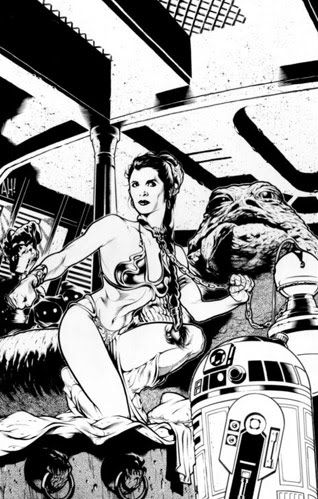
During his childhood in Riverside, New Jersey, Hughes exhibited artistic tendencies at a young age. He says he always had a feeling he'd either make his way to outer space, or draw his path there.
"I was raised watching moon landings [on TV], and really wanted to be an astronaut," Hughes says. "The only other thing I was good at was drawing. Not that I was good at being an astronaut; I was 5. But I was good at wanting to be an astronaut."
As he dreamt of traveling to the moon, he soon was introduced to another galaxy worthy of exploration.
"I am a first generation Star Wars nerd," Hughes admits. "I was just turning 10 in May of 1977. I became a fan about two minutes into my first screening, at the Eric Cinemas in Pennsauken, New Jersey. My mother couldn't drive home fast enough for me to get to my pen and paper so I could start drawing Star Wars."
As the years passed by, Hughes found himself seriously contemplating a career in art.
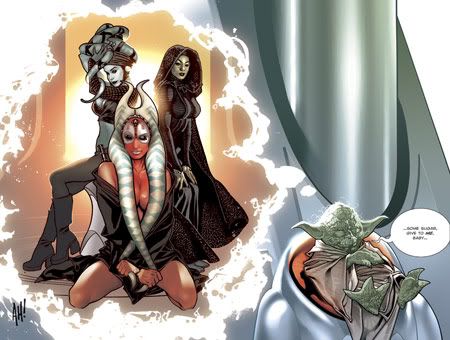
"When I escaped from high school, I gave myself a certain amount of time to get a career in comics going," Hughes recalls. "My New Year's resolution for 1987 was to give myself five years to get into comics. If I didn't do it by then, I'd learn a trade. I was invited to a New Year's party thrown by Neil Vokes and Rick Rankin, who were self-publishing their mystical kung fu comic Eagle. They offered me a pin-up [assignment], which I spent all New Year's Day working on. It snowed like it was Alaska, so it was a good day, all snowed in with nothing but my very first assignment and some music to keep me company. As New Year's resolutions go, I think a 24-hour turnaround is pretty good." EDITOR'S NOTE: IT'S PEOPLE LIKE THIS, THAT GIVE THE REST OF OUR NOT-YET-REALIZED RESOLUTIONS A BAD RAP.
Instead of attending college, Hughes continued to pursue freelance art assignments, honing his skills as an artist, and looking to other illustrators and painters for inspiration including Norman Rockwell, Alphonse Mucha, Dean Cornwell, Drew Struzan, Mike Mignola, Kevin Nowlan, Steve Rude, among many others.
It wasn't long before Hughes' unique style was in demand. In 1988, Hughes illustrated both the cover and interior content to the comic book Maze Agency, and a year later began work on DC Comic's Justice League series. But it was his work on the Dark Horse series Ghost, a 4-year run of Wonder Woman covers for DC Comics, and his own GEN-13: Ordinary Heroes for Wildstorm that seemed to gain Hughes the most recognition from his ever-growing fan base.
Of course, Star Wars fans might recognize Hughes more for his covers for the Classic Star Wars movie adaptations where he's captured the epic moment where Luke Skywalker and Princess Leia swing over the cavernous Death Star chasm, and an equally memorable scene featuring Princess Leia in her infamous metal bikini costume.
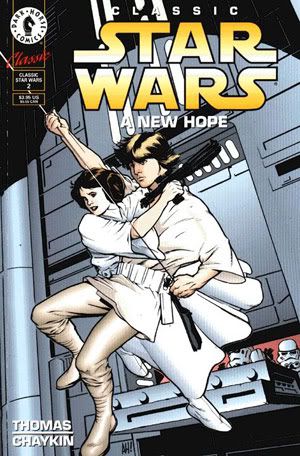
A Soft Spot for Luke
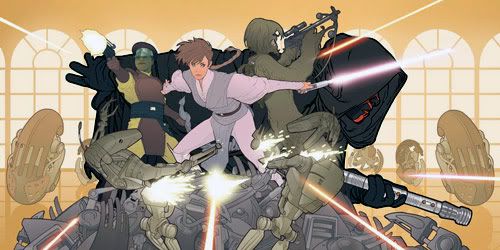
Hughes also began creating designs for Wizards of the Coast roleplaying games such as the Star Wars: Invasion of Theed Adventure Game.
For Theed, Hughes was asked to introduce fans to new heroes through his illustrations of the teen Wookiee scout, Rorworr and the female Jedi guardian, Sia-Lan Wezz.
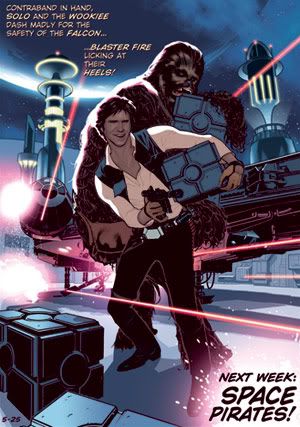
Even with the exciting challenge of designing new characters for the roleplaying games, Hughes says he still has a soft spot for drawing one of the characters that initially sparked his interest in the Star Wars saga -- Luke Skywalker.
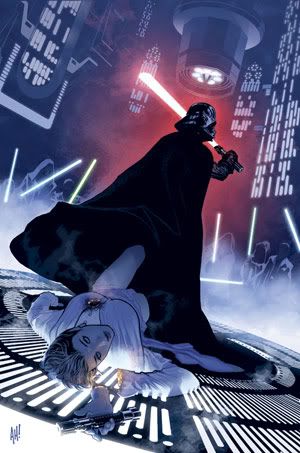
"I've been a fan since the old days, back when Star Wars was 'the adventures of Luke Skywalker,'" Hughes explains. "When I get to draw Luke, it takes me back to a powerful personal moment. When Luke leaves the dinner table and goes off to have his moment of melancholy with Tatooine's twin suns, that was the first time in my life I ever had an emotional reaction to a piece of music. Think about that; think about how music affects you. If you're the type of person who can really find yourself moved by music, think if you can remember the very first time music generated a feeling in you. I can. John Williams, Mark Hamill, and George Lucas; all those cats are responsible for the moment when I got the opera in me."
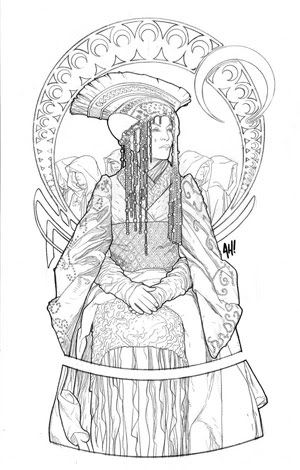
And when he's not drawing members of the Skywalker clan, he lends his talents to other fan-favorite properties.
"I've also dabbled in one or two Hollywood projects, all with Buffy the Vampire Slayer and Serenity creator Joss Whedon," Hughes says. "I did the covers for Wonder Woman for five years; that went well. I'm the cover artist on Catwoman right now; we'll see how that works out."
Using both traditional artist tools such as a French sable hair Scharff watercolor brush and digital media like Adobe Photoshop, Hughes' uniquely polished style resonates with collectors and fans alike. In fact, at any given convention, it's easy to spot where Hughes is signing -- just look for the long line of eager fans.
"Meeting fans is great," Hughes says. "You get great feedback that helps inform your work, and you sometimes find out that you made somebody's day at one point or another."
However, Hughes is quick to add that in addition to making is fans happy, he'd also like to have his art make a difference.
"I don't have a big ego, but I really want my life's work to matter," Hughes smiles. "That's not so bad, is it?"
Fans can catch Hughes' art next on the cover of Star Wars: Purge.
To see more of Hughes' work, visit his official site here. http://www.justsayah.com/
Drawing Anakin Skywalker
Ever wanted to draw Star Wars characters and vehicles just like the professional comic book artists? EDITOR'S NOTE: YES. YES I WOULD! (UNFORTUNATELY, A LACK OF TALENT POSES A BIT OF A PROBLEM FOR ME)
In this step-by-step series, Star Wars artists and illustrators show you how to draw some of the most beloved characters in the saga, as well as new faces and creatures from Star Wars: Episode III Revenge of the Sith (available on DVD Nov. 1).
So get your pencils and paper ready! EDITOR'S NOTE: AWW, SHUCKS, KIDS! LET'S GIVE IT A GO, EH?!
In Episode III, fans see Anakin Skywalker at his darkest. Caught in the middle of his duty as a Jedi and his fear of visions of his wife Padmé's death coming true, Anakin must choose his destiny.
Star Wars illustrator Matt Busch explains his super-easy steps on how to draw a troubled Anakin Skywalker.
Steps 1-6 are to be drawn lightly with a pencil. No pen, no dark lines. Finished lines and details will come at the end.
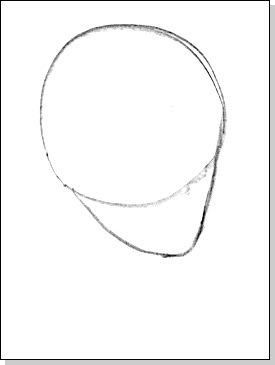
Step One:This is an angle of the head that is half-way turned between a straight 'head-on' view and a side profile. First draw a circle. This will represent the cranium of the head that you will build on. Next add the jaw below, tapering it slightly to the right. You have now drawn the basic shapes for the major bones that make up the human skull: the cranium and the mandible
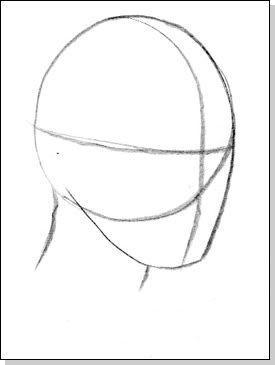
Step Two:To find out the placement of the facial features, you need to map out where they will be. First bisect the face vertically. If this was a 'head-on' view, you would simply draw a line down the middle of the head, however, since this is a three-quarter view, you need to nudge that vertical line towards the right. Also make sure that it curves towards the middle at the top. This will make it appear to be wrapping back over the head. Next bisect the head horizontally. This line represents placement of the eyes and top of the ear. It should be half-way from the top of the head, to the bottom of the chin. Add two lines that will represent the neck, under the jaw and extending from the back of the head.
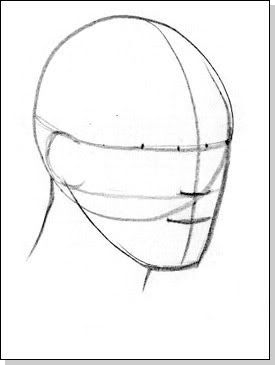
Step Three:The horizontal placement of the eyes for a head-on view is five-eye spaces across. Since this is a three-quarter view, nudge those spaces to the right. Use your vertical bisecting line to find the center of the horizontal eye placement. You'll want about an eye space in between both of the eyes.
To figure out where the nose should go draw another horizontal line that is halfway from the eye placement line to the bottom of the jaw. The nose will be centered on your vertical bisecting line, and is about an eye space wide.
Also map out the ear shape towards the back of the head. The ear is the same distance as the nose -- it fits between the horizontal eye and nose lines.The horizontal line placement for the mouth is about a third of the way down from the bottom of the nose to the bottom of the jaw. For the distance the mouth is across, you can usually match it vertically with the center of both eyes.
You now have the basic head mapped out!
Now on to the fun stuff!
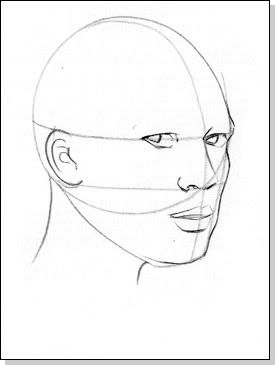
Step Four:Using the basic construction you built for the head, you can now begin to add the features more clearly. You can begin with the eyes, which have a basic almond shape.
Normally, the top of the iris is covered slightly covered by the top eyelid.
Next up is the ear and nose. Do not over-draw them. Less is always more.
You want to make an indication of them, and people's imaginations will fill in the rest.
You can now draw the mouth with more detail as well. For drawing men, you want to be careful not to draw the lip lines to dark, or it will look like they are wearing lipstick! EDITOR'S NOTE: ANAKIN IN DRAG!
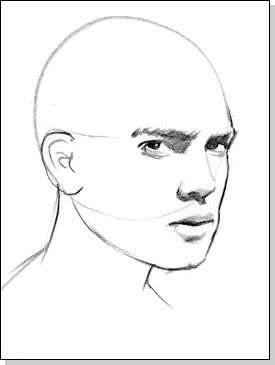
Step Five:Once you have the basic features mapped out how you like them, you can start to erase your construction lines, and draw the features in darker and with more confidence.
This is important to making your drawing look professional.
The eyes are very important, since it's what people will focus on most. Drawing in furrowed eyebrows will help add some sinister mystery to Anakin's overall look. Some shading under his brow will also set his eyes back, and help give that troubled look of his unknown destiny.
Shade in his blue irises, but the darkest part will be the black pupil in the center. Render out the nose, ear and mouth better, too.
A small cast shadow under the nose will help to make it look like it's protruding from the face. For the lips, the upper lip is angled down, so it's always darker. However, adding a cast shadow under the bottom lip will help to make it look like it's protruding, just like the nose.
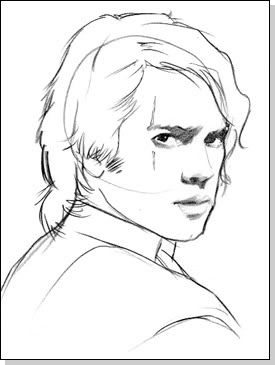
Step Six:Are you tired of Anakin being bald? Me too! Go ahead and draw in a basic contour of his long untamed locks. His hair is wavy, and pretty messy. Make sure it lifts a little from his head, instead of being glued close like a ski hat.
We're going to add a slight indication of Anakin's shoulder, as portraits of just a head without a neck and shoulders often look really creepy -- and not the kind of 'Anakin-creepy' we're looking for.
When adding the Jedi tunic, remember that Anakin is looking over his shoulder, so it's almost as if we see more of his back.
Lastly, you can add the vertical scar above and below the eye on the left.

Step Seven:Now that your linear drawing is complete, the last thing you can do is some shading to really make your drawing come to life.
Slight form shadows will indicate the jawbone and other planes of the face.
Hair is sometimes tricky, and especially tricky in Anakin's case. Look closely at some photos you have of Anakin from books, magazines, and trading cards, and even use them as reference when drawing the hair.
To really make your drawing look top-notch, you often need to spend just as much time on every square inch of the hair as you do on every square inch of the face.
From Astronaut to Artist
Princess Leia, Wonder Woman, Vampirella, Cat Woman, Lara Croft, and Storm all have one man in common, and he's not wearing a cape or carrying a lightsaber. Artist Adam Hughes has a rare talent for transforming legendary comic book heroines into modern-day Mona Lisas.
Known by many fans for his "good girl" pin-up style art, Hughes is considered to be one of the greatest artistic contributors in the world of comics today. He's drawn covers and art for such titles as Star Wars, The Justice League, Star Trek, Buffy the Vampire Slayer, Tomb Raider, Legionnaires, Ghost and Gen 13, only to name a few.

During his childhood in Riverside, New Jersey, Hughes exhibited artistic tendencies at a young age. He says he always had a feeling he'd either make his way to outer space, or draw his path there.
"I was raised watching moon landings [on TV], and really wanted to be an astronaut," Hughes says. "The only other thing I was good at was drawing. Not that I was good at being an astronaut; I was 5. But I was good at wanting to be an astronaut."
As he dreamt of traveling to the moon, he soon was introduced to another galaxy worthy of exploration.
"I am a first generation Star Wars nerd," Hughes admits. "I was just turning 10 in May of 1977. I became a fan about two minutes into my first screening, at the Eric Cinemas in Pennsauken, New Jersey. My mother couldn't drive home fast enough for me to get to my pen and paper so I could start drawing Star Wars."
As the years passed by, Hughes found himself seriously contemplating a career in art.

"When I escaped from high school, I gave myself a certain amount of time to get a career in comics going," Hughes recalls. "My New Year's resolution for 1987 was to give myself five years to get into comics. If I didn't do it by then, I'd learn a trade. I was invited to a New Year's party thrown by Neil Vokes and Rick Rankin, who were self-publishing their mystical kung fu comic Eagle. They offered me a pin-up [assignment], which I spent all New Year's Day working on. It snowed like it was Alaska, so it was a good day, all snowed in with nothing but my very first assignment and some music to keep me company. As New Year's resolutions go, I think a 24-hour turnaround is pretty good." EDITOR'S NOTE: IT'S PEOPLE LIKE THIS, THAT GIVE THE REST OF OUR NOT-YET-REALIZED RESOLUTIONS A BAD RAP.
Instead of attending college, Hughes continued to pursue freelance art assignments, honing his skills as an artist, and looking to other illustrators and painters for inspiration including Norman Rockwell, Alphonse Mucha, Dean Cornwell, Drew Struzan, Mike Mignola, Kevin Nowlan, Steve Rude, among many others.
It wasn't long before Hughes' unique style was in demand. In 1988, Hughes illustrated both the cover and interior content to the comic book Maze Agency, and a year later began work on DC Comic's Justice League series. But it was his work on the Dark Horse series Ghost, a 4-year run of Wonder Woman covers for DC Comics, and his own GEN-13: Ordinary Heroes for Wildstorm that seemed to gain Hughes the most recognition from his ever-growing fan base.
Of course, Star Wars fans might recognize Hughes more for his covers for the Classic Star Wars movie adaptations where he's captured the epic moment where Luke Skywalker and Princess Leia swing over the cavernous Death Star chasm, and an equally memorable scene featuring Princess Leia in her infamous metal bikini costume.

A Soft Spot for Luke

Hughes also began creating designs for Wizards of the Coast roleplaying games such as the Star Wars: Invasion of Theed Adventure Game.
For Theed, Hughes was asked to introduce fans to new heroes through his illustrations of the teen Wookiee scout, Rorworr and the female Jedi guardian, Sia-Lan Wezz.

Even with the exciting challenge of designing new characters for the roleplaying games, Hughes says he still has a soft spot for drawing one of the characters that initially sparked his interest in the Star Wars saga -- Luke Skywalker.

"I've been a fan since the old days, back when Star Wars was 'the adventures of Luke Skywalker,'" Hughes explains. "When I get to draw Luke, it takes me back to a powerful personal moment. When Luke leaves the dinner table and goes off to have his moment of melancholy with Tatooine's twin suns, that was the first time in my life I ever had an emotional reaction to a piece of music. Think about that; think about how music affects you. If you're the type of person who can really find yourself moved by music, think if you can remember the very first time music generated a feeling in you. I can. John Williams, Mark Hamill, and George Lucas; all those cats are responsible for the moment when I got the opera in me."

And when he's not drawing members of the Skywalker clan, he lends his talents to other fan-favorite properties.
"I've also dabbled in one or two Hollywood projects, all with Buffy the Vampire Slayer and Serenity creator Joss Whedon," Hughes says. "I did the covers for Wonder Woman for five years; that went well. I'm the cover artist on Catwoman right now; we'll see how that works out."
Using both traditional artist tools such as a French sable hair Scharff watercolor brush and digital media like Adobe Photoshop, Hughes' uniquely polished style resonates with collectors and fans alike. In fact, at any given convention, it's easy to spot where Hughes is signing -- just look for the long line of eager fans.
"Meeting fans is great," Hughes says. "You get great feedback that helps inform your work, and you sometimes find out that you made somebody's day at one point or another."
However, Hughes is quick to add that in addition to making is fans happy, he'd also like to have his art make a difference.
"I don't have a big ego, but I really want my life's work to matter," Hughes smiles. "That's not so bad, is it?"
Fans can catch Hughes' art next on the cover of Star Wars: Purge.
To see more of Hughes' work, visit his official site here. http://www.justsayah.com/
Drawing Anakin Skywalker
Ever wanted to draw Star Wars characters and vehicles just like the professional comic book artists? EDITOR'S NOTE: YES. YES I WOULD! (UNFORTUNATELY, A LACK OF TALENT POSES A BIT OF A PROBLEM FOR ME)
In this step-by-step series, Star Wars artists and illustrators show you how to draw some of the most beloved characters in the saga, as well as new faces and creatures from Star Wars: Episode III Revenge of the Sith (available on DVD Nov. 1).
So get your pencils and paper ready! EDITOR'S NOTE: AWW, SHUCKS, KIDS! LET'S GIVE IT A GO, EH?!
In Episode III, fans see Anakin Skywalker at his darkest. Caught in the middle of his duty as a Jedi and his fear of visions of his wife Padmé's death coming true, Anakin must choose his destiny.
Star Wars illustrator Matt Busch explains his super-easy steps on how to draw a troubled Anakin Skywalker.
Steps 1-6 are to be drawn lightly with a pencil. No pen, no dark lines. Finished lines and details will come at the end.

Step One:This is an angle of the head that is half-way turned between a straight 'head-on' view and a side profile. First draw a circle. This will represent the cranium of the head that you will build on. Next add the jaw below, tapering it slightly to the right. You have now drawn the basic shapes for the major bones that make up the human skull: the cranium and the mandible

Step Two:To find out the placement of the facial features, you need to map out where they will be. First bisect the face vertically. If this was a 'head-on' view, you would simply draw a line down the middle of the head, however, since this is a three-quarter view, you need to nudge that vertical line towards the right. Also make sure that it curves towards the middle at the top. This will make it appear to be wrapping back over the head. Next bisect the head horizontally. This line represents placement of the eyes and top of the ear. It should be half-way from the top of the head, to the bottom of the chin. Add two lines that will represent the neck, under the jaw and extending from the back of the head.

Step Three:The horizontal placement of the eyes for a head-on view is five-eye spaces across. Since this is a three-quarter view, nudge those spaces to the right. Use your vertical bisecting line to find the center of the horizontal eye placement. You'll want about an eye space in between both of the eyes.
To figure out where the nose should go draw another horizontal line that is halfway from the eye placement line to the bottom of the jaw. The nose will be centered on your vertical bisecting line, and is about an eye space wide.
Also map out the ear shape towards the back of the head. The ear is the same distance as the nose -- it fits between the horizontal eye and nose lines.The horizontal line placement for the mouth is about a third of the way down from the bottom of the nose to the bottom of the jaw. For the distance the mouth is across, you can usually match it vertically with the center of both eyes.
You now have the basic head mapped out!
Now on to the fun stuff!

Step Four:Using the basic construction you built for the head, you can now begin to add the features more clearly. You can begin with the eyes, which have a basic almond shape.
Normally, the top of the iris is covered slightly covered by the top eyelid.
Next up is the ear and nose. Do not over-draw them. Less is always more.
You want to make an indication of them, and people's imaginations will fill in the rest.
You can now draw the mouth with more detail as well. For drawing men, you want to be careful not to draw the lip lines to dark, or it will look like they are wearing lipstick! EDITOR'S NOTE: ANAKIN IN DRAG!

Step Five:Once you have the basic features mapped out how you like them, you can start to erase your construction lines, and draw the features in darker and with more confidence.
This is important to making your drawing look professional.
The eyes are very important, since it's what people will focus on most. Drawing in furrowed eyebrows will help add some sinister mystery to Anakin's overall look. Some shading under his brow will also set his eyes back, and help give that troubled look of his unknown destiny.
Shade in his blue irises, but the darkest part will be the black pupil in the center. Render out the nose, ear and mouth better, too.
A small cast shadow under the nose will help to make it look like it's protruding from the face. For the lips, the upper lip is angled down, so it's always darker. However, adding a cast shadow under the bottom lip will help to make it look like it's protruding, just like the nose.

Step Six:Are you tired of Anakin being bald? Me too! Go ahead and draw in a basic contour of his long untamed locks. His hair is wavy, and pretty messy. Make sure it lifts a little from his head, instead of being glued close like a ski hat.
We're going to add a slight indication of Anakin's shoulder, as portraits of just a head without a neck and shoulders often look really creepy -- and not the kind of 'Anakin-creepy' we're looking for.
When adding the Jedi tunic, remember that Anakin is looking over his shoulder, so it's almost as if we see more of his back.
Lastly, you can add the vertical scar above and below the eye on the left.

Step Seven:Now that your linear drawing is complete, the last thing you can do is some shading to really make your drawing come to life.
Slight form shadows will indicate the jawbone and other planes of the face.
Hair is sometimes tricky, and especially tricky in Anakin's case. Look closely at some photos you have of Anakin from books, magazines, and trading cards, and even use them as reference when drawing the hair.
To really make your drawing look top-notch, you often need to spend just as much time on every square inch of the hair as you do on every square inch of the face.
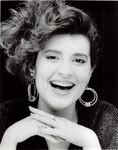

0 Comments:
Post a Comment
<< Home